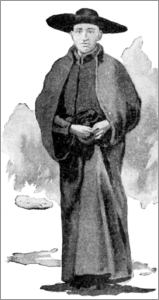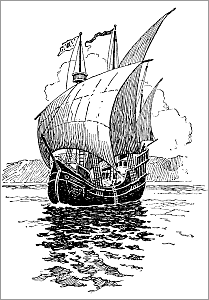| Home > Floripedia > French Colony | |
French Colony
A History of Florida1904
Spanish Missionaries. Several years after De Soto's expedition, a few earnest priests determined to try to teach the Christian religion to the Indians of Florida. Until now all who had visited the strange land had come in the name of an earthly king, seeking wealth, glory, and honor. These came in the name of a heavenly king to bring the knowledge of God and His goodness. On reaching Tampa Bay two of the priests tried to land, thinking they would go together into the interior of the country. But it was not to be so. The natives, with their war clubs, were assembled on the coast, and with heavy blows instantly killed both priests. Then another of the pious men said that he would land alone so as to show the natives that he came in peace. Yet no sooner had he landed than he too fell dead under the warriors' clubs. Discouraged by his sad fate and seeing that it was of no use to try to land, his companions sorrowfully gave up hope of teaching the Indians and set sail for Havana.
How did the Indians receive the Spanish priests?
Attempted Settlement by De Luna. So far every effort wade by the Spaniards to conquer Florida had failed. In 1556 King Philip determined to intrust the troublesome matter to the governor of Mexico, Don Luis de Velasco. He was a very wise, just man and had dealt fairly with the Indians of Mexico, always protecting them in their rights. So it was hoped that he might win the friendship of the warlike Indians of Florida and make a peaceable settlement of the country. Three years later, the expedition so carefully planned sailed from Vera Cruz, Mexico, under the command of Don Tristan de Luna. It landed near the future site of Pensacola. The party numbered fifteen hundred soldiers and settlers, bsides priests to convert the Indians. They had a year's supply of provisions.

A MissionaryBut this expedition, planned with such forethought, was no more successful in making a settlement than others had been. A settlement was indeed attempted just where Pensacola was afterward built, but it was given up. After many weary marches and disappointments the Spaniards returned to Mexico, or to the West Indies, and King Philip II declared that he would make no further attempt to settle Florida, as there was no danger of the French trying to do so.
What was the next effort to make a settlement in Florida? Who led the expedition? Where did they lane and settle?
France and the Huguenots. Perhaps France might have thought more of making colonies in the New World if she had been less busy at home. In 1524 Verrazani, an Italian sailor in the service of France, had explored and claimed for that nation the coast from Carolina to Nova Scotia, calling it New France. You remember that Spain had claimed the same land as part of Florida. Yet it was not until after De Luna's expedition that the French tried to found a colony on the territory claimed by both nations.
There was but little peace or safety in France for the Huguenots, as the Protestants there were called. Their leader, the great Admiral Coligny, had for a long time wished to establish a safe home for them in America, where they would be free to worship God in their own faith. He first attempted a settlement on the coast of Brazil, and though this proved a failure, Coligny was not altogether discouraged.
Discovery of St. Johns River. He obtained a commission from the king of France, Charles IX., and sent an expedition to North America under the command of the brave, Jean Ribault. Ribault sailed from France February, 1562, his two vessels carrying some of the best men of France. He reached Florida near the latitude of St. Augustine, but did not land, sailing northward along the coast. He discovered the river called by the Indians Welaka, but now called St. Johns. Ribault named it the River of May, because he saw it on the first day of May. As he sailed along the coast, he gave French names to the capes and named the rivers for the rivers of France.
What was the outcome of De Luna's expedition? Why was Philip willing to give up settling Florida? What had the eastern coast of the present United States been called by the Spanish? By the French? Who was Coligny? Whom did he wish to colonize in America? Why? Where had he attempted a settlement?
French at Port Royal, 1562. At last he came to the fine harbor of Port Royal and here decided to make the settlement. A small fort was built and called Fort Caroline in honor of King Charles of France. Twenty-six men were left to hold possession of the fort, and Ribault, expecting soon to return, set sail for France. When he arrived there he found civil war raging, and he could not return then to carry aid to the little fort.
What did Ribault discover? Where did he land?
Meanwhile things went badly indeed at Fort Caroline. The Indians had been friendly, but the soldiers had quarreled among themselves. When provisions became scarce and there was no sign of help, they mutinied and killed their captain. They said they would return home at all hazards, for they could not longer bear life in the wilderness. So they made a frail little boat, and set out for the perilous voyage across the ocean. Their provisions gave out before the voyage was half ended, and all would have perished had they not been rescued by an English vessel.
Settlement on St. Johns. After many months of a so-called religious war, a peace, or pretense of peace, was made between Charles IX. and his Huguenot subjects, and now Coligny asked that help be given for the little colony across the ocean. The king consented, and three ships were fitted out. The command of these was given to Rene de Laudonniere, one of those who had been with Ribault on his first voyage.
Instead of Port Royal, the site selected for this colony was on the southern side of the St. Johns River (which they called the River of May), a few miles from the mouth. Here they built a fort, called, like the first, Fort Caroline. The fort was triangular, and was built entirely of sand and logs.
The natives received the newcomers very kindly. They came to see them, bringing presents of vegetables and fruit, showed the French how to plant corn and make fish traps, and did all they could to help the strangers to get on in the new land.
What became of Ribault's colony? Who commanded the next French expedition? Where was the settlement made? How was the fort built?
Unfortunately the colonists were not the sort of men to get on in a new country. They became discontented there were many disputes, and finally they lost the friendship of the Indians by harshness and unfairness. They thought gold could be found in Florida, and in looking for it wasted time that might better have been spent in planting crops.

French VesselReenforcements. The French had landed in Florida in June, 1564. In the spring of the next year, supplies had become so scarce that the colonists determined to make such vessels as they could and return to France. About this time Sir John Hawkins, a famous English seaman, came sailing along the coast in search of fresh water. He was very generous to the colonists, and gave them, not only a large supply of provisions, but a vessel from his fleet. Delighted now, the homesick colonists made preparations to return to France. But their friends at home had not forgotten them. On the very day set for sailing, August 29, 1565, the sails of Ribault's long expected vessels were seen approaching. There were seven vessels, bringing families of emigrants, domestic animals, tools, seeds, and supplies of every kind. So the French remained, but Sir John Hawkins had gone his way.
How were the French received by the Indians? What did the Indians teach them? What was the cause of trouble? Of the failure? Of the colony? What aid did they receive?
A Rich Land. Sir John Hawkins gave an account of the French colony when he reached England, and said that he could not understand why they had been in such need. "For," he wrote, "the ground doth yield victuals sufficient . . . . The ground yieldeth naturally grapes in great store . . . . Also it yieldeth roots, passing good; deer marvelous good, with divers other beasts and fowls serviceable to the use of man. There be things wherewith a man may live, having maize wherewith to make bread." He mentioned the trees that grew in the country, cedar, cypress and others, saying "better cannot be found in the world." He was struck, too, with the many valuable medicinal plants he found. In naming the animals of the country he said that he had heard there were also lions, tigers, and unicorns, but the honest gentleman did not say that he had himself seen these.
Source:
Excerpt from Part One, Chapter Five, "A French Colony in Florida" A History of Florida, 1904. Next Section; Table of Contents.
| Home > Floripedia > French Colony |
Exploring
Florida: A Social Studies Resource for Students and Teachers
Produced by the Florida Center for Instructional
Technology,
College of Education, University of South Florida © 2005.